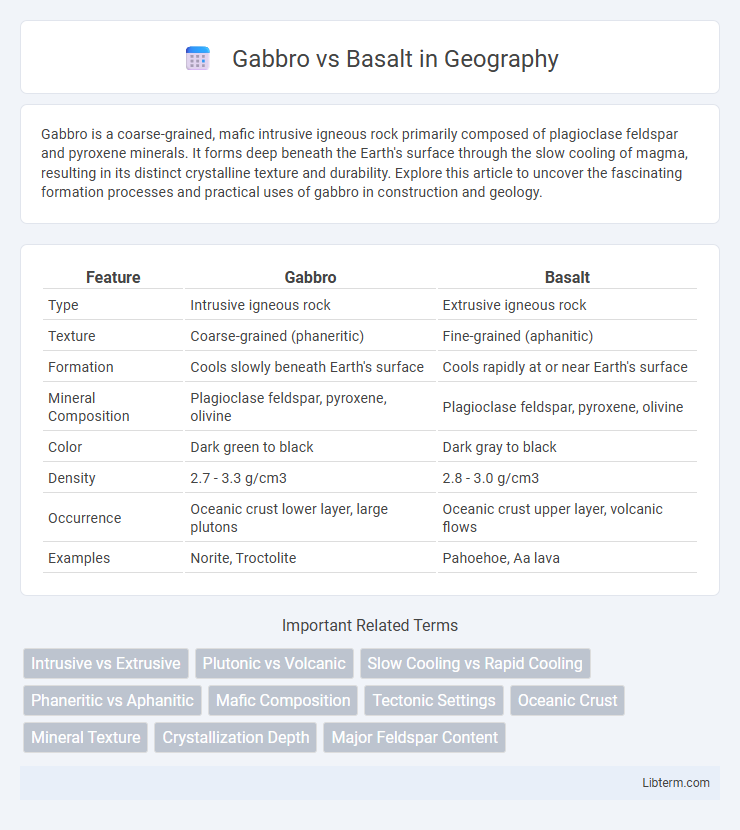Gabbro is a coarse-grained, mafic intrusive igneous rock primarily composed of plagioclase feldspar and pyroxene minerals. It forms deep beneath the Earth's surface through the slow cooling of magma, resulting in its distinct crystalline texture and durability. Explore this article to uncover the fascinating formation processes and practical uses of gabbro in construction and geology.
Table of Comparison
| Feature | Gabbro | Basalt |
|---|---|---|
| Type | Intrusive igneous rock | Extrusive igneous rock |
| Texture | Coarse-grained (phaneritic) | Fine-grained (aphanitic) |
| Formation | Cools slowly beneath Earth's surface | Cools rapidly at or near Earth's surface |
| Mineral Composition | Plagioclase feldspar, pyroxene, olivine | Plagioclase feldspar, pyroxene, olivine |
| Color | Dark green to black | Dark gray to black |
| Density | 2.7 - 3.3 g/cm3 | 2.8 - 3.0 g/cm3 |
| Occurrence | Oceanic crust lower layer, large plutons | Oceanic crust upper layer, volcanic flows |
| Examples | Norite, Troctolite | Pahoehoe, Aa lava |
Introduction to Gabbro and Basalt
Gabbro and basalt are both mafic igneous rocks primarily composed of plagioclase feldspar and pyroxene, formed from the cooling of magma rich in magnesium and iron. Gabbro is a coarse-grained intrusive rock that crystallizes slowly beneath the Earth's surface, resulting in larger mineral grains, while basalt is a fine-grained extrusive rock that cools quickly on the surface, producing smaller crystals. These compositional and textural differences influence their geological applications and physical properties in Earth's crust.
Formation Processes of Gabbro and Basalt
Gabbro forms from the slow cooling and solidification of magma beneath the Earth's surface, resulting in coarse-grained intrusive igneous rock. Basalt originates from rapid cooling of lava at or near the Earth's surface, producing fine-grained extrusive igneous rock. Both rocks are mafic and share similar chemical compositions but differ significantly in texture due to their contrasting cooling histories.
Mineral Composition Comparison
Gabbro primarily consists of coarse-grained plagioclase feldspar, pyroxene, and minor olivine, giving it a mafic mineral composition richer in calcium-rich plagioclase. Basalt features fine-grained textures dominated by plagioclase and pyroxene minerals, but with a higher abundance of iron and magnesium-rich minerals compared to gabbro. Both igneous rocks share similar mafic minerals but differ in grain size and cooling history, impacting their overall mineral composition and texture.
Texture and Grain Size Differences
Gabbro exhibits a coarse-grained, phaneritic texture characterized by visible, interlocking crystals typically larger than 1 millimeter due to slow cooling beneath the Earth's surface. Basalt displays a fine-grained, aphanitic texture with microscopic crystals formed from rapid cooling at or near the surface, resulting in grains smaller than 1 millimeter. The contrasting grain size and texture between gabbro and basalt reflect their different cooling rates and intrusive versus extrusive igneous origins.
Color and Visual Appearance
Gabbro exhibits a coarse-grained texture with a dark green to black color, often displaying visible crystals of feldspar and pyroxene. Basalt, in contrast, has a fine-grained texture and typically appears dark gray to black with a more uniform and smooth surface. The visual distinction lies in gabbro's crystalline, speckled look versus basalt's consistent, dense appearance.
Occurrence and Geological Settings
Gabbro primarily forms as a coarse-grained intrusive igneous rock within oceanic crust and large layered mafic intrusions associated with divergent plate boundaries and continental flood basalts. Basalt is a fine-grained extrusive igneous rock commonly found in mid-ocean ridges, oceanic islands, and continental flood basalt provinces, resulting from rapid cooling of lava at or near the Earth's surface. Both are mafic and chemically similar, but their distinct geological settings reflect differences in cooling rates and emplacement depths.
Uses and Applications in Industry
Gabbro's coarse-grained texture and durability make it ideal for construction aggregates, dimension stone, and road base materials, especially in heavy-duty applications requiring high compressive strength. Basalt is extensively used in the production of basalt fiber for reinforcing concrete, thermal insulation, and fireproofing materials, offering superior resistance to chemical and thermal stress. Both rocks serve as important raw materials in the manufacturing of crushed stone, but basalt's fine-grained structure lends itself better to industrial uses such as cast stone and polished slabs.
Durability and Weathering Properties
Gabbro exhibits superior durability compared to basalt due to its coarse-grained texture and slower cooling process, which results in a denser, more interlocked mineral structure. Basalt weathers more quickly in exposed environments because of its fine-grained composition and higher susceptibility to chemical breakdown, particularly in acidic or humid conditions. Gabbro's resilience makes it preferred in construction projects requiring long-term stability, while basalt is often favored for applications needing rapid cooling and widespread availability.
Key Differences Summarized
Gabbro and basalt are both mafic igneous rocks but differ primarily in their cooling rates and textures; gabbro forms slowly beneath the Earth's surface, resulting in coarse-grained crystals, while basalt cools rapidly at the surface and has a fine-grained texture. Chemically, both rocks are similar in composition, rich in iron and magnesium minerals like pyroxene and plagioclase feldspar, but gabbro's mineral grains are visibly larger due to its intrusive origin. Their distinct formation environments influence their physical properties, making gabbro denser and more coarse-textured compared to the typically more vesicular and fine-grained basalt.
Conclusion: Choosing Between Gabbro and Basalt
Gabbro and basalt differ primarily in texture and formation, with gabbro being coarse-grained and intrusive, while basalt is fine-grained and extrusive. Choosing between gabbro and basalt depends on the specific application, as gabbro offers greater durability and aesthetic appeal for construction and decorative uses, whereas basalt's density and rapid cooling properties make it suitable for road base and industrial aggregates. Understanding the distinct physical and chemical characteristics of gabbro versus basalt ensures optimal material selection for geological, architectural, and engineering projects.
Gabbro Infographic

 libterm.com
libterm.com